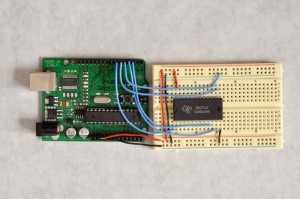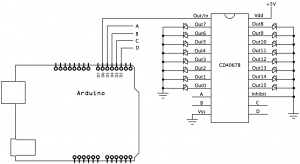This tutorial will show how to control multiple LED outputs from a microcontroller using a CD4067 analog multiplexer.
This is a stub. More explanation will follow, but for now, here are schematics and code for Arduino.
Parts you’ll need:
- CD4067B multiplexer
- Arduino microcontroller
- LEDs
The Circuit
The code
/* Multiplexer output example Controls 16 outputs, one at a time, using a CD4067B multiplexer. This sketch loops over the 16 channels of a CD4067 multiplexer, switching the input to each output channel in turn. It then fades up and down the input channel using analogWrite(). The circuit: * CD4067 multiplexer attached as follows: - address pin A: digital I/O 2 - address pin B: digital I/O 3 - address pin C: digital I/O 4 - address pin D: digital I/O 5 - input pin: digital I/O pin 6 - LEDs attached from each of the CD4067's output channels to ground created 21 May 2009 by Tom Igoe https://tigoe.com/pcomp/code/category/arduinowiring/540 for more */ // put the address pin numbers in an array // so they're easier to iterate over: const int channel[] = { 2, 3, 4, 5}; // the output pin channel (mux's input): const int outputPin = 6; void setup() { // set up all pins as output: for (int thisPin = 2; thisPin < 7; thisPin++) { pinMode(thisPin, OUTPUT); } } void loop() { // iterate over the 16 channels of the multiplexer: for (int thisChannel = 0; thisChannel < 16; thisChannel++) { // set the channel pins based on the channel you want: muxWrite(thisChannel); // fade the current channel up: for (int brightness = 0; brightness < 256; brightness++) { analogWrite(outputPin, brightness); delay(5); } } } void muxWrite(int whichChannel) { // iterate over the number of pins you're using: for (int thisPin = 0; thisPin < 4; thisPin++) { // calculate the state of this pin based on // its bit value in whichChannel: int pinState = bitRead(whichChannel, thisPin); // turn the pin on or off: digitalWrite(channel[thisPin],pinState); } }



One Reply to “CD4067 Multiplexer used to control LEDs”
Comments are closed.